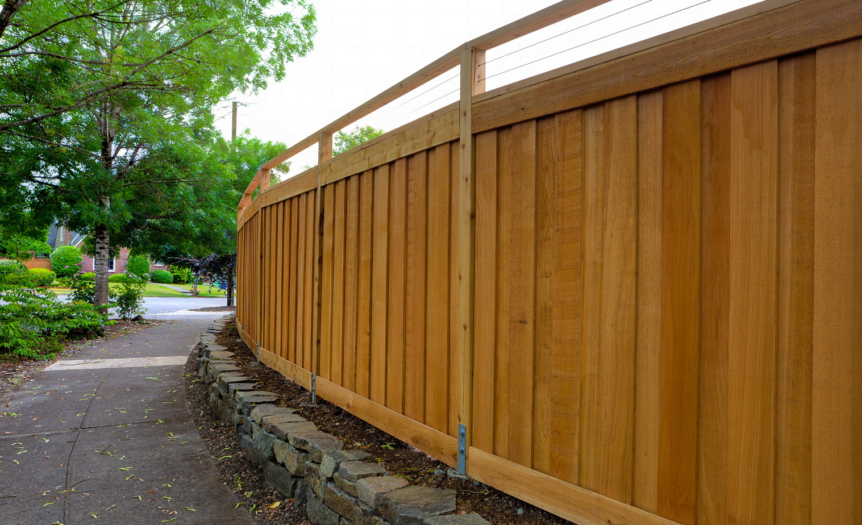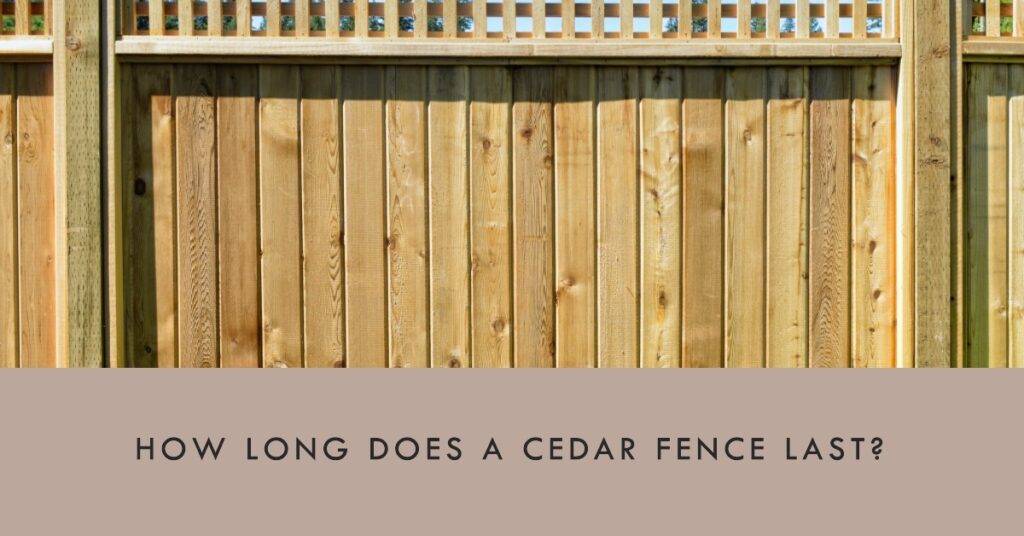Cedar fences are highly sought-after for their natural beauty, durability, and ability to withstand various weather conditions. Homeowners often wonder “how long does a cedar fence last?” In this blog, we will explore the factors that affect the lifespan of a cedar fence and provide practical tips for extending its longevity.
We’ll also compare cedar with other popular fencing materials to help you make an informed decision about the best choice for your home.
Factors Affecting The Lifespan Of A Cedar Fence
The lifespan of a cedar fence largely depends on several factors including the type and quality of the cedar wood used, climate and weather conditions, as well as proper installation and maintenance.
Type And Quality Of Cedar Wood Used
The type and quality of cedar wood used for constructing a fence plays a significant role in determining its longevity. Cedar is available in various species, such as Western Red Cedar, Eastern Red Cedar, and Northern White Cedar – each having distinct properties that contribute to the fence’s durability.
Western Red Cedar, for instance, boasts exceptional decay resistance due to its natural oils and tannins, which effectively repel insects and fungi.
In addition to the specific species of cedar chosen, other factors affecting the lifespan of your cedar fence include the grade (quality) and finish applied to the planks.
Higher grades tend to be more resistant to rotting or warping as they contain fewer knots or sapwood content; however, they may also come at a higher cost comparatively. A well-selected wood finishes can further enhance your fence’s longevity by providing added protection against moisture infiltration and harmful UV rays from sunlight exposure.
Video Credit (Butler Contracting)
Climate And Weather Conditions
The climate and weather conditions in your area can significantly affect the lifespan of a cedar fence. Extreme temperature changes, high winds, heavy rainfall or snowfall, and prolonged exposure to UV rays can all contribute to damage and wear on your fence.
For example, if you live in an area with hot summers and cold winters like the Midwest or Northeast regions of the United States, you may need to take extra precautions to ensure your cedar fence lasts as long as possible.
This could include regular cleaning and sealing to prevent moisture buildup that leads to wood rot, trimming surrounding trees and foliage that cause excessive shade or wind resistance against the fence panels, and repairing any damage immediately before it spreads.
Installation And Maintenance
Proper installation and maintenance are crucial for ensuring the longevity of your cedar fence. For installation, it’s important to choose a reputable contractor that has experience with installing wood fences.
Maintenance also plays a big role in how long your cedar fence will last. Regular cleaning with soap and water, as well as sealing and staining every few years can help prevent moisture from penetrating the wood and causing rot or warping.
Trimming surrounding trees and foliage is another way to extend the life of your cedar fence by preventing excess moisture buildup.
The Average Lifespan Of A Cedar Fence
On average, an untreated cedar fence can last up to 12 years in the ground and 15-20 years above ground; however, with proper maintenance such as regular cleaning and staining, a treated cedar fence can last up to 30 years.
Untreated Cedar: 12 Years In The Ground And 15-20 Years Above Ground
If you’re considering an untreated cedar fence, it’s important to know that its lifespan may not be as long as treated cedar or other materials. On average, an untreated cedar fence can last around 12 years in the ground and up to 15-20 years above ground.
However, there are still benefits to choosing untreated cedar for your fence. It’s a more affordable option than some other materials and has a beautiful natural color that many homeowners prefer.
Plus, with proper maintenance such as regular cleaning and staining or sealing every few years, you can extend the lifespan of your untreated cedar fence even further.
Treated Cedar: Up To 30 Years With Proper Maintenance
If you want your cedar fence to last as long as possible, treating it with a protective coating can make a significant difference. Treated cedar fences can last up to 30 years or more, depending on factors like the quality of the wood and local climate conditions.
However, even with treatment, there are no guarantees when it comes to maximizing the lifespan of your fence. Heavy windstorms or exposure to excess moisture may cause damage that requires repair or restoration in order to maintain structural integrity.
Tips For Extending The Lifespan Of Your Cedar Fence
To keep your cedar fence looking great and lasting longer, make sure to regularly clean, seal and stain it. Don’t forget to address any damage or wear as soon as possible, trim surrounding trees and foliage that can cause moisture buildup or windstorm damage, and choose quality installation and maintenance services for optimal results.
Regular Cleaning, Sealing And Staining
To extend the lifespan of your cedar fence, regular maintenance is crucial. Regular cleaning helps remove dirt and grime that can accumulate on the surface of the fence, which can lead to discoloration and weaken the wood over time.
Sealing and staining are also important to protect your cedar fence from elements like rain, sunlight, and extreme temperatures. Applying sealant every few years creates a barrier between the wood and moisture, preventing rotting or warping.
Aside from these three steps (cleaning, sealing, and staining), it is essential to address any damages or wear as soon as possible. Nailing loose boards back in place promptly prevents further damage or deterioration caused by weather conditions.
Addressing Damage And Wear
Whether it’s due to windstorms or just everyday wear and tear, your cedar fence may experience damage over time. It’s important to address these issues promptly to ensure the longevity of your fence.
Some common types of wear and tear on a cedar fence include rotting, warping, cracking, and discoloration.
If you notice any signs of damage on your cedar fence, taking swift action can prevent further deterioration that could make repairs costlier later on. Regular maintenance also helps extend the lifespan of your fence overall.
By trimming surrounding trees and foliage regularly to prevent moisture buildup from occurring around the base of the posts; doing so is critical for preventing wood rot from setting in as well.
Trimming Surrounding Trees And Foliage
Another important factor in prolonging the lifespan of your cedar fence is trimming surrounding trees and foliage. Overgrown plants can lead to a buildup of debris, which can hold moisture against the wood and cause rotting over time.
Fallen leaves and branches can also scratch or damage the surface of your fence. It’s best to trim any plants growing near or touching your fence regularly to prevent these issues from arising.
For example, if you have trees next to your cedar fence, make sure branches aren’t rubbing against it during windy weather. If they are, trim them back before they do too much harm.
By following these tips along with regular maintenance – including staining or sealing every few years – you’ll help extend the life of your cedar fence significantly while retaining its beauty and strength for many years to come!
Preventing Moisture Buildup
One of the biggest threats to the longevity of a cedar fence is moisture buildup. When wood is exposed to moisture, it can lead to rotting and decay, which can weaken the structure of your fence.
To prevent moisture buildup, make sure that water isn’t pooling around the base of your fence by ensuring proper drainage in the surrounding area. Additionally, trim back any trees or foliage that may be blocking sunlight from reaching your fence as this will slow down evaporation and promote moisture buildup.
It’s also important to regularly inspect your cedar fence for signs of damage and wear caused by weathering or other factors such as insect infestations. By addressing these issues promptly with repairs or replacement parts where necessary, you’ll be able to ensure that your cedar fence stays strong and sturdy for years to come.
Choosing Quality Installation And Maintenance
To ensure the longevity of your cedar fence, it’s essential to choose quality installation and maintenance services. Proper installation by a skilled professional will help prevent damage caused by windstorms or improper placement that could lead to early rotting.
Maintenance is also crucial in extending the lifespan of your cedar fence. Regular cleaning helps remove dirt and debris buildup that can cause discoloration or weaken the wood fibers.
Staining every few years prevents UV exposure from causing damage while preventing moisture from penetrating deep into the wood’s surface.
Comparing Cedar Fences With Other Wood Types
When it comes to choosing the best wood for your fence, cedar is a popular choice due to its natural resistance to decay and insect damage. But how does it compare with other wood types? In this section, we’ll take a closer look at the pros and cons of cedar fences vs pine, redwood, pressure-treated wood, composite materials and vinyl so you can make an informed decision.
Cedar Vs. Pine
When it comes to choosing the right wood for your fence, cedar and pine are two of the most popular options. While both woods offer affordability and versatility, there are some key differences to consider.
Cedar is known for its natural resistance to decay, pests, and moisture build-up, making it a great option for outdoor use.
If you’re looking for a fence that will last longer with minimal maintenance requirements, then cedar might be your best bet. However, if cost is a significant factor in your decision-making process or you plan to take extra steps to protect your fence from wear and tear over time – such as regular staining or sealing – then pine could still be an excellent choice.
Cedar Vs. Redwood
Both cedar and redwood are popular choices for wood fences due to their natural resistance to decay, insects, and rot. While cedar is a more affordable option, redwood boasts high durability and strength that allow it to last longer without treatment or staining.
Redwood has a richer color as well, which makes it an attractive choice for homeowners who want a fence that blends in with their landscape.
When choosing between the two types of wood for your fence project, consider your budget and the level of maintenance you’re willing to commit to. Both options require some upkeep over time, including cleaning and sealing regularly.
Cedar Vs. Pressure-treated Wood
When comparing cedar and pressure-treated wood for fencing, it’s important to consider both durability and cost. Pressure-treated wood is typically cheaper than cedar, but it also has a shorter lifespan.
Cedar also offers natural resistance to decay and insects, which means that you won’t have to worry about chemical treatments or other forms of protection. In the long run, this could save you time and money on maintenance costs.
Ultimately, your choice between cedar and pressure-treated wood will depend on your specific needs and budget. If you’re looking for a low-cost option that requires minimal upkeep but has a shorter lifespan, pressure treated might be the way to go.
Cedar Vs. Composite Materials
Cedar and composite materials are two popular options for fences, but they have significant differences. Cedar is a natural wood that has been used for centuries because of its durability, beauty, and resistance to rot and insects.
While cedar fences require more maintenance than composite ones – staining every few years compared to not having to do anything with composites – cedar ultimately offers better longevity if it’s taken care of correctly.
Composite materials will only last around 15-25 years before they begin to fade or discolor without proper maintenance; whereas a cedar fence can last up to twice that length with the right treatment.
Additionally, when it comes time for replacement or removal, composite fencing cannot be reused or recycled like natural cedar can be.
Cedar Vs. Vinyl
Cedar and vinyl are two popular materials used in fencing. While vinyl is a more recent addition to the market, cedar has been a traditional option for centuries. Cedar fences have a natural beauty that comes from their grain patterns and colors, which become richer with age.
In contrast, vinyl fences offer a clean look that doesn’t change much over time. One of the primary benefits of vinyl is its low maintenance requirements.
Despite requiring more upkeep than its counterpart, many homeowners still prefer the classic look of cedar fencing compared to sterile-looking vinyl options. Cedar’s durability stems from being naturally resistant to decay and insects meaning you won’t have to worry about it as long as you follow maintenance procedures such as staining every few years or sealing splits as they appear.
Conclusion
In conclusion, the longevity of a cedar fence depends on several factors such as the type and quality of wood used, climate and weather conditions, installation, and maintenance.
To extend the lifespan of your cedar fence, it’s crucial to regularly clean, seal, stain it properly while addressing any damage or wear.
Cedar outperforms other wood types like pine or spruce although not as long-lasting as redwood.
By following these tips and choosing quality installation and maintenance techniques you can ensure that your cedar fence remains a beautiful addition to your property for many years!







